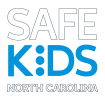© 2025 BuckleUpNC.org | Site built and maintained by UNC Highway Safety Research Center
Site supported by:



Full text of the law is available from the NC General Assembly.
The North Carolina Child Passenger Safety Law requires children less than age 16 to be properly restrained in an age, weight, and height appropriate restraint. Passengers age 16 and older are covered by the North Carolina Seat Belt Law.
The NC Child Passenger Safety Law applies to all vehicles required by federal standards to have seat belts. This includes all passenger cars manufactured after 1967 and vans, pickups, and SUVs manufactured after 1971.
A properly used car seat or booster seat is required for children less than age 8 and less than 80 pounds. The law does not specify which type of car seat can be used at any age or weight, only that the seat is used properly in accordance with the manufacturer’s instructions and meets all Federal Safety Standards in place when the seat was manufactured.
When a child reaches age 8 (regardless of weight) or 80 pounds (regardless of age), a properly fitted seat belt can be used in place of a car seat or booster seat.
Booster seats can only be used with lap and shoulder seat belts. They can NEVER be used with a lap belt only. A child who weighs at least 40 pounds can legally be restrained using only a properly fitted lap belt if there is no lap and shoulder belt available for use with a booster seat, however this is not considered to be the safest option.
Children who are less than age 5 and less than 40 pounds must be restrained in the back seat if the vehicle has a passenger side front airbag and has a rear seat.
The following exemptions to the law exist: